Business Structure, Governance, and Risks: Adani Australia Analysis
VerifiedAdded on 2022/10/04
|9
|2210
|231
Essay
AI Summary
This report analyzes Adani Australia, examining its business structure, governance, and operational aspects. The study explores the company's organizational structure, including its board of directors and corporate governance practices, highlighting transparency and accountability. It delves into environmental factors influencing performance, differentiating between internal and external elements such as planning, policies, resource availability, and micro and macro factors. The report identifies various risks faced by the company, including market, credit, liquidity, strategic, and operational risks, and discusses risk management strategies. Furthermore, it examines Adani's business practices, including its corporate social responsibility initiatives, green mining policies, and sustainability efforts. The analysis also covers the functional departments within Adani, such as HR, operations, purchasing, and legal, emphasizing their roles in achieving the company's goals. The conclusion summarizes the key findings, emphasizing the company's strategies for growth, the impact of environmental factors, and the challenges it faces in a changing market.
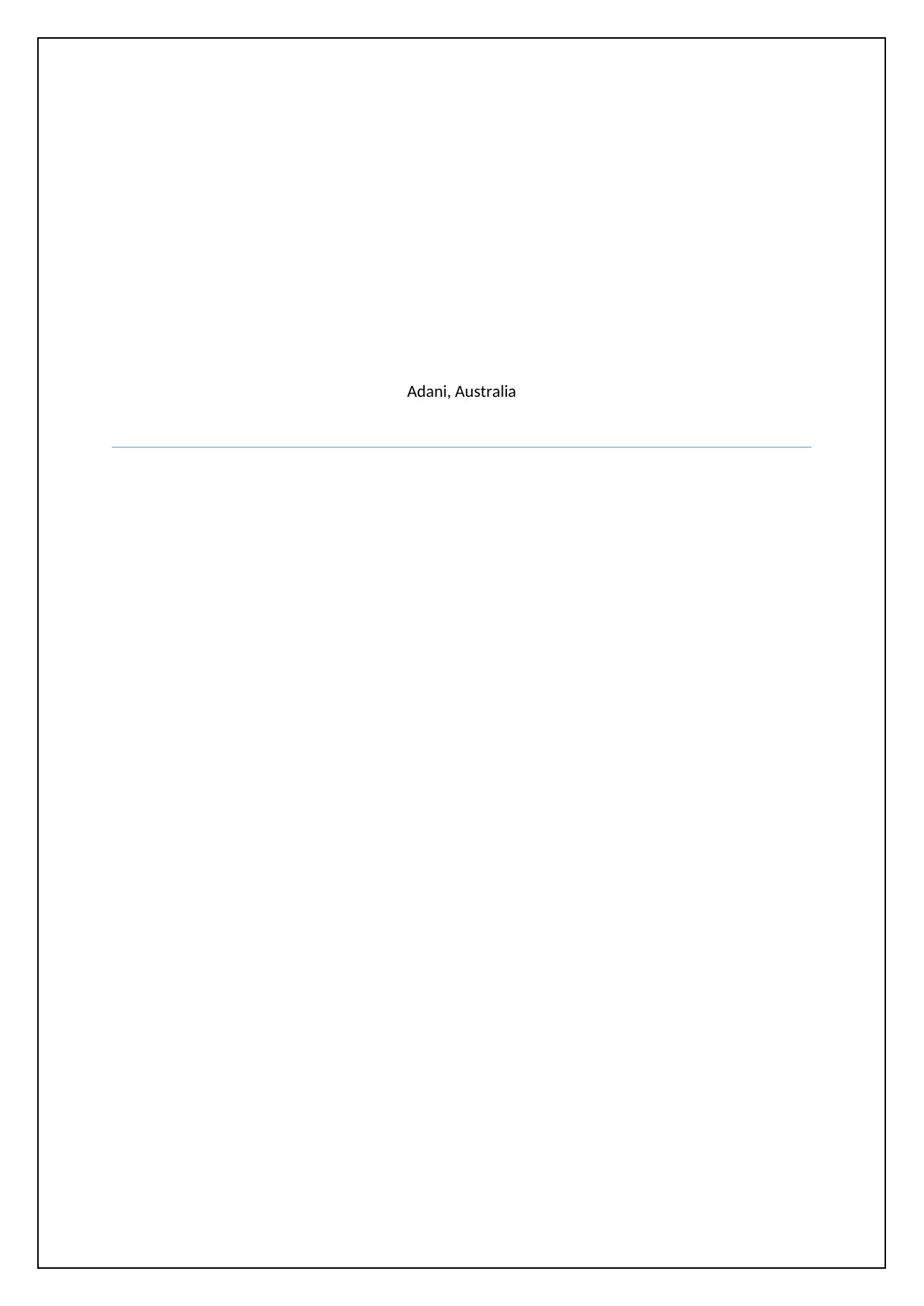
Adani, Australia
Paraphrase This Document
Need a fresh take? Get an instant paraphrase of this document with our AI Paraphraser
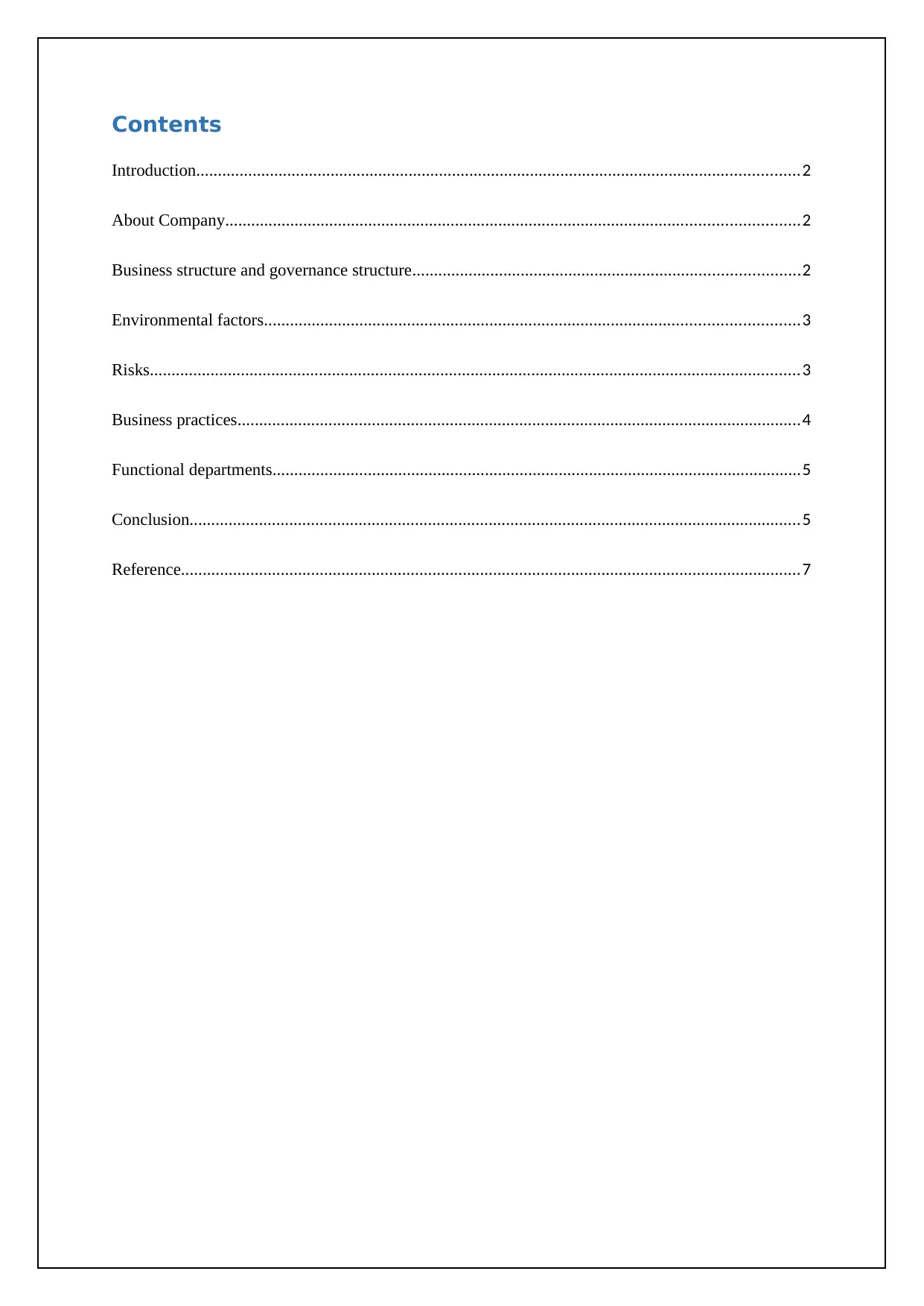
Contents
Introduction...........................................................................................................................................2
About Company....................................................................................................................................2
Business structure and governance structure.........................................................................................2
Environmental factors...........................................................................................................................3
Risks......................................................................................................................................................3
Business practices..................................................................................................................................4
Functional departments..........................................................................................................................5
Conclusion.............................................................................................................................................5
Reference...............................................................................................................................................7
Introduction...........................................................................................................................................2
About Company....................................................................................................................................2
Business structure and governance structure.........................................................................................2
Environmental factors...........................................................................................................................3
Risks......................................................................................................................................................3
Business practices..................................................................................................................................4
Functional departments..........................................................................................................................5
Conclusion.............................................................................................................................................5
Reference...............................................................................................................................................7
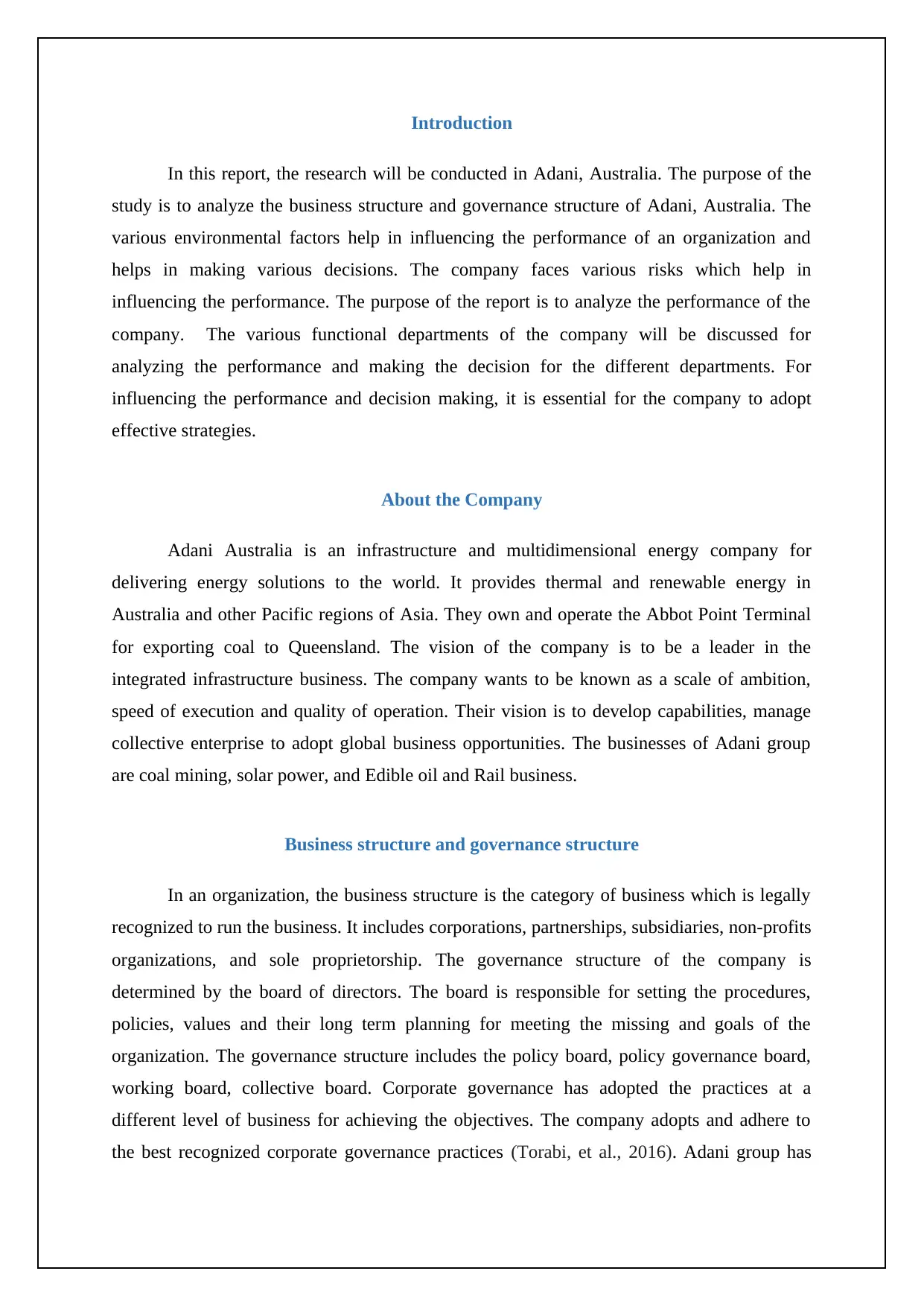
Introduction
In this report, the research will be conducted in Adani, Australia. The purpose of the
study is to analyze the business structure and governance structure of Adani, Australia. The
various environmental factors help in influencing the performance of an organization and
helps in making various decisions. The company faces various risks which help in
influencing the performance. The purpose of the report is to analyze the performance of the
company. The various functional departments of the company will be discussed for
analyzing the performance and making the decision for the different departments. For
influencing the performance and decision making, it is essential for the company to adopt
effective strategies.
About the Company
Adani Australia is an infrastructure and multidimensional energy company for
delivering energy solutions to the world. It provides thermal and renewable energy in
Australia and other Pacific regions of Asia. They own and operate the Abbot Point Terminal
for exporting coal to Queensland. The vision of the company is to be a leader in the
integrated infrastructure business. The company wants to be known as a scale of ambition,
speed of execution and quality of operation. Their vision is to develop capabilities, manage
collective enterprise to adopt global business opportunities. The businesses of Adani group
are coal mining, solar power, and Edible oil and Rail business.
Business structure and governance structure
In an organization, the business structure is the category of business which is legally
recognized to run the business. It includes corporations, partnerships, subsidiaries, non-profits
organizations, and sole proprietorship. The governance structure of the company is
determined by the board of directors. The board is responsible for setting the procedures,
policies, values and their long term planning for meeting the missing and goals of the
organization. The governance structure includes the policy board, policy governance board,
working board, collective board. Corporate governance has adopted the practices at a
different level of business for achieving the objectives. The company adopts and adhere to
the best recognized corporate governance practices (Torabi, et al., 2016). Adani group has
In this report, the research will be conducted in Adani, Australia. The purpose of the
study is to analyze the business structure and governance structure of Adani, Australia. The
various environmental factors help in influencing the performance of an organization and
helps in making various decisions. The company faces various risks which help in
influencing the performance. The purpose of the report is to analyze the performance of the
company. The various functional departments of the company will be discussed for
analyzing the performance and making the decision for the different departments. For
influencing the performance and decision making, it is essential for the company to adopt
effective strategies.
About the Company
Adani Australia is an infrastructure and multidimensional energy company for
delivering energy solutions to the world. It provides thermal and renewable energy in
Australia and other Pacific regions of Asia. They own and operate the Abbot Point Terminal
for exporting coal to Queensland. The vision of the company is to be a leader in the
integrated infrastructure business. The company wants to be known as a scale of ambition,
speed of execution and quality of operation. Their vision is to develop capabilities, manage
collective enterprise to adopt global business opportunities. The businesses of Adani group
are coal mining, solar power, and Edible oil and Rail business.
Business structure and governance structure
In an organization, the business structure is the category of business which is legally
recognized to run the business. It includes corporations, partnerships, subsidiaries, non-profits
organizations, and sole proprietorship. The governance structure of the company is
determined by the board of directors. The board is responsible for setting the procedures,
policies, values and their long term planning for meeting the missing and goals of the
organization. The governance structure includes the policy board, policy governance board,
working board, collective board. Corporate governance has adopted the practices at a
different level of business for achieving the objectives. The company adopts and adhere to
the best recognized corporate governance practices (Torabi, et al., 2016). Adani group has
⊘ This is a preview!⊘
Do you want full access?
Subscribe today to unlock all pages.

Trusted by 1+ million students worldwide
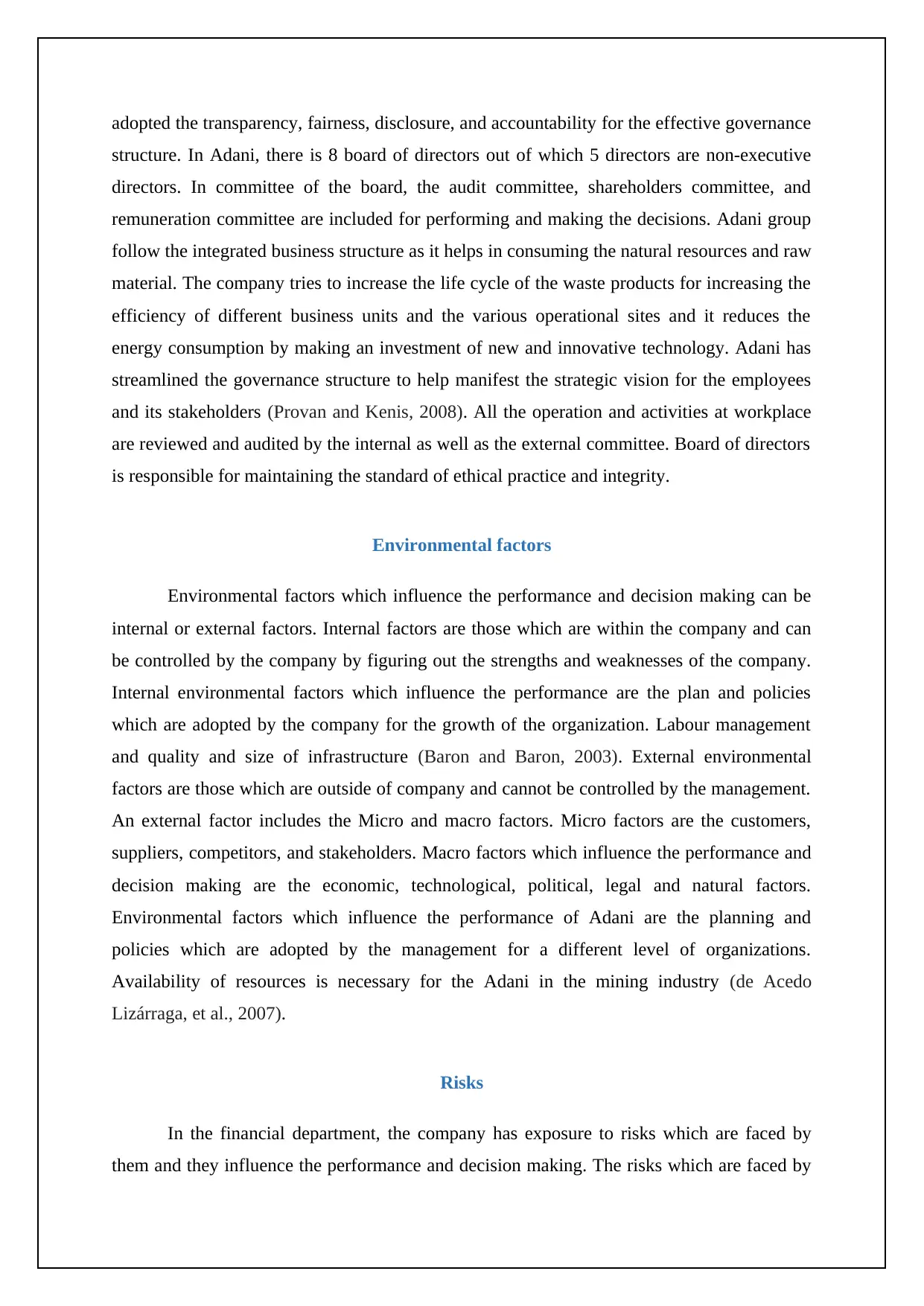
adopted the transparency, fairness, disclosure, and accountability for the effective governance
structure. In Adani, there is 8 board of directors out of which 5 directors are non-executive
directors. In committee of the board, the audit committee, shareholders committee, and
remuneration committee are included for performing and making the decisions. Adani group
follow the integrated business structure as it helps in consuming the natural resources and raw
material. The company tries to increase the life cycle of the waste products for increasing the
efficiency of different business units and the various operational sites and it reduces the
energy consumption by making an investment of new and innovative technology. Adani has
streamlined the governance structure to help manifest the strategic vision for the employees
and its stakeholders (Provan and Kenis, 2008). All the operation and activities at workplace
are reviewed and audited by the internal as well as the external committee. Board of directors
is responsible for maintaining the standard of ethical practice and integrity.
Environmental factors
Environmental factors which influence the performance and decision making can be
internal or external factors. Internal factors are those which are within the company and can
be controlled by the company by figuring out the strengths and weaknesses of the company.
Internal environmental factors which influence the performance are the plan and policies
which are adopted by the company for the growth of the organization. Labour management
and quality and size of infrastructure (Baron and Baron, 2003). External environmental
factors are those which are outside of company and cannot be controlled by the management.
An external factor includes the Micro and macro factors. Micro factors are the customers,
suppliers, competitors, and stakeholders. Macro factors which influence the performance and
decision making are the economic, technological, political, legal and natural factors.
Environmental factors which influence the performance of Adani are the planning and
policies which are adopted by the management for a different level of organizations.
Availability of resources is necessary for the Adani in the mining industry (de Acedo
Lizárraga, et al., 2007).
Risks
In the financial department, the company has exposure to risks which are faced by
them and they influence the performance and decision making. The risks which are faced by
structure. In Adani, there is 8 board of directors out of which 5 directors are non-executive
directors. In committee of the board, the audit committee, shareholders committee, and
remuneration committee are included for performing and making the decisions. Adani group
follow the integrated business structure as it helps in consuming the natural resources and raw
material. The company tries to increase the life cycle of the waste products for increasing the
efficiency of different business units and the various operational sites and it reduces the
energy consumption by making an investment of new and innovative technology. Adani has
streamlined the governance structure to help manifest the strategic vision for the employees
and its stakeholders (Provan and Kenis, 2008). All the operation and activities at workplace
are reviewed and audited by the internal as well as the external committee. Board of directors
is responsible for maintaining the standard of ethical practice and integrity.
Environmental factors
Environmental factors which influence the performance and decision making can be
internal or external factors. Internal factors are those which are within the company and can
be controlled by the company by figuring out the strengths and weaknesses of the company.
Internal environmental factors which influence the performance are the plan and policies
which are adopted by the company for the growth of the organization. Labour management
and quality and size of infrastructure (Baron and Baron, 2003). External environmental
factors are those which are outside of company and cannot be controlled by the management.
An external factor includes the Micro and macro factors. Micro factors are the customers,
suppliers, competitors, and stakeholders. Macro factors which influence the performance and
decision making are the economic, technological, political, legal and natural factors.
Environmental factors which influence the performance of Adani are the planning and
policies which are adopted by the management for a different level of organizations.
Availability of resources is necessary for the Adani in the mining industry (de Acedo
Lizárraga, et al., 2007).
Risks
In the financial department, the company has exposure to risks which are faced by
them and they influence the performance and decision making. The risks which are faced by
Paraphrase This Document
Need a fresh take? Get an instant paraphrase of this document with our AI Paraphraser
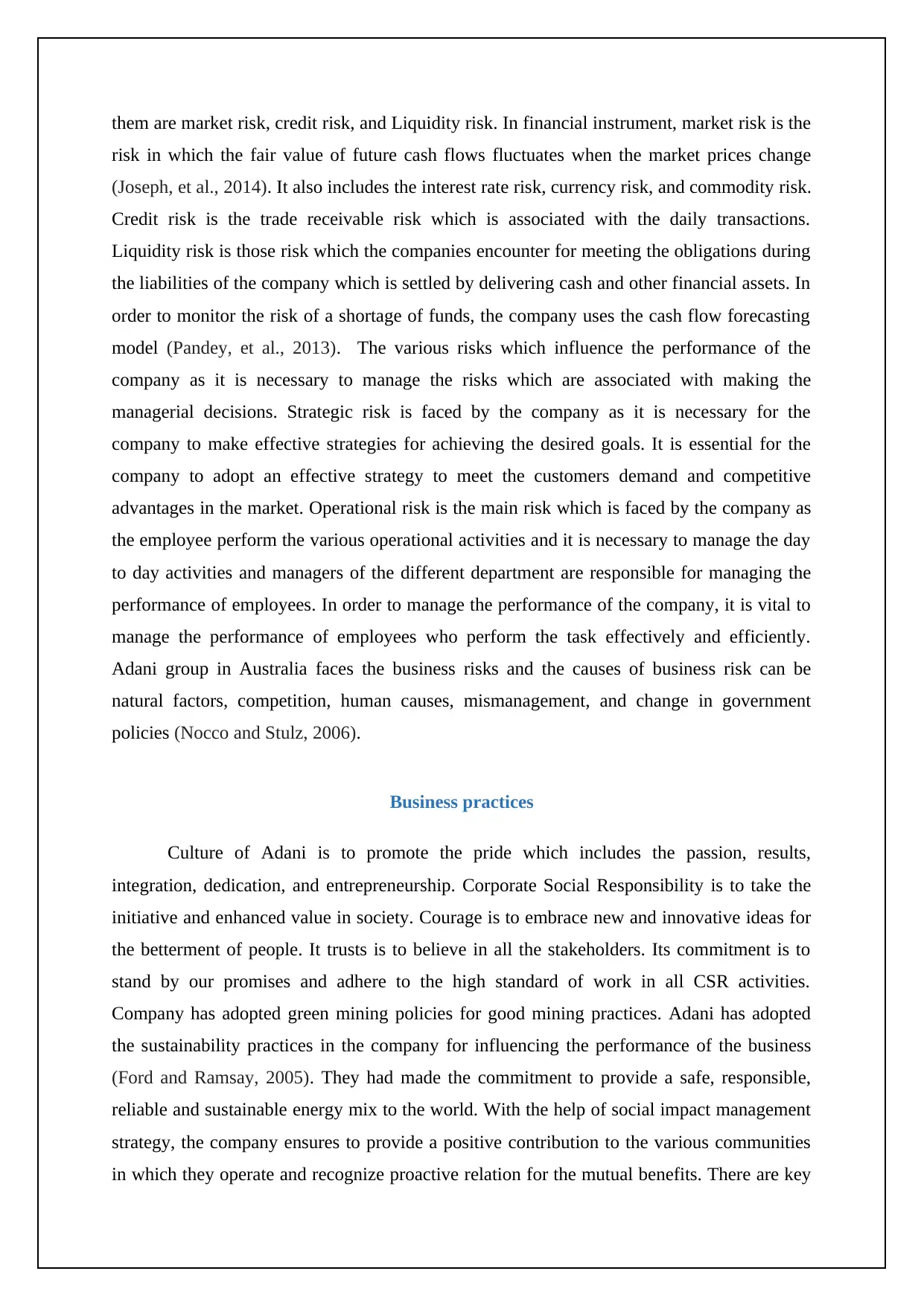
them are market risk, credit risk, and Liquidity risk. In financial instrument, market risk is the
risk in which the fair value of future cash flows fluctuates when the market prices change
(Joseph, et al., 2014). It also includes the interest rate risk, currency risk, and commodity risk.
Credit risk is the trade receivable risk which is associated with the daily transactions.
Liquidity risk is those risk which the companies encounter for meeting the obligations during
the liabilities of the company which is settled by delivering cash and other financial assets. In
order to monitor the risk of a shortage of funds, the company uses the cash flow forecasting
model (Pandey, et al., 2013). The various risks which influence the performance of the
company as it is necessary to manage the risks which are associated with making the
managerial decisions. Strategic risk is faced by the company as it is necessary for the
company to make effective strategies for achieving the desired goals. It is essential for the
company to adopt an effective strategy to meet the customers demand and competitive
advantages in the market. Operational risk is the main risk which is faced by the company as
the employee perform the various operational activities and it is necessary to manage the day
to day activities and managers of the different department are responsible for managing the
performance of employees. In order to manage the performance of the company, it is vital to
manage the performance of employees who perform the task effectively and efficiently.
Adani group in Australia faces the business risks and the causes of business risk can be
natural factors, competition, human causes, mismanagement, and change in government
policies (Nocco and Stulz, 2006).
Business practices
Culture of Adani is to promote the pride which includes the passion, results,
integration, dedication, and entrepreneurship. Corporate Social Responsibility is to take the
initiative and enhanced value in society. Courage is to embrace new and innovative ideas for
the betterment of people. It trusts is to believe in all the stakeholders. Its commitment is to
stand by our promises and adhere to the high standard of work in all CSR activities.
Company has adopted green mining policies for good mining practices. Adani has adopted
the sustainability practices in the company for influencing the performance of the business
(Ford and Ramsay, 2005). They had made the commitment to provide a safe, responsible,
reliable and sustainable energy mix to the world. With the help of social impact management
strategy, the company ensures to provide a positive contribution to the various communities
in which they operate and recognize proactive relation for the mutual benefits. There are key
risk in which the fair value of future cash flows fluctuates when the market prices change
(Joseph, et al., 2014). It also includes the interest rate risk, currency risk, and commodity risk.
Credit risk is the trade receivable risk which is associated with the daily transactions.
Liquidity risk is those risk which the companies encounter for meeting the obligations during
the liabilities of the company which is settled by delivering cash and other financial assets. In
order to monitor the risk of a shortage of funds, the company uses the cash flow forecasting
model (Pandey, et al., 2013). The various risks which influence the performance of the
company as it is necessary to manage the risks which are associated with making the
managerial decisions. Strategic risk is faced by the company as it is necessary for the
company to make effective strategies for achieving the desired goals. It is essential for the
company to adopt an effective strategy to meet the customers demand and competitive
advantages in the market. Operational risk is the main risk which is faced by the company as
the employee perform the various operational activities and it is necessary to manage the day
to day activities and managers of the different department are responsible for managing the
performance of employees. In order to manage the performance of the company, it is vital to
manage the performance of employees who perform the task effectively and efficiently.
Adani group in Australia faces the business risks and the causes of business risk can be
natural factors, competition, human causes, mismanagement, and change in government
policies (Nocco and Stulz, 2006).
Business practices
Culture of Adani is to promote the pride which includes the passion, results,
integration, dedication, and entrepreneurship. Corporate Social Responsibility is to take the
initiative and enhanced value in society. Courage is to embrace new and innovative ideas for
the betterment of people. It trusts is to believe in all the stakeholders. Its commitment is to
stand by our promises and adhere to the high standard of work in all CSR activities.
Company has adopted green mining policies for good mining practices. Adani has adopted
the sustainability practices in the company for influencing the performance of the business
(Ford and Ramsay, 2005). They had made the commitment to provide a safe, responsible,
reliable and sustainable energy mix to the world. With the help of social impact management
strategy, the company ensures to provide a positive contribution to the various communities
in which they operate and recognize proactive relation for the mutual benefits. There are key
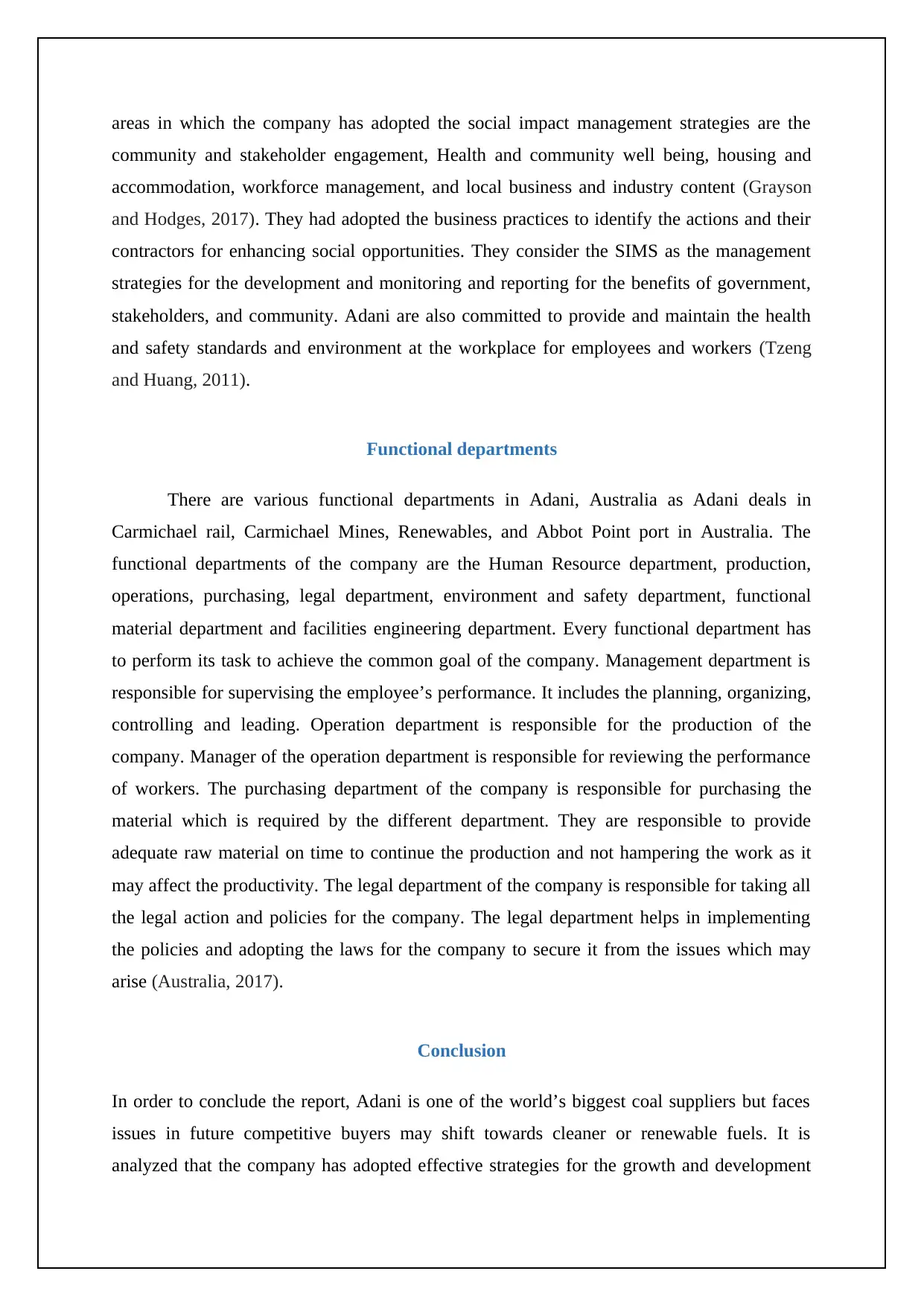
areas in which the company has adopted the social impact management strategies are the
community and stakeholder engagement, Health and community well being, housing and
accommodation, workforce management, and local business and industry content (Grayson
and Hodges, 2017). They had adopted the business practices to identify the actions and their
contractors for enhancing social opportunities. They consider the SIMS as the management
strategies for the development and monitoring and reporting for the benefits of government,
stakeholders, and community. Adani are also committed to provide and maintain the health
and safety standards and environment at the workplace for employees and workers (Tzeng
and Huang, 2011).
Functional departments
There are various functional departments in Adani, Australia as Adani deals in
Carmichael rail, Carmichael Mines, Renewables, and Abbot Point port in Australia. The
functional departments of the company are the Human Resource department, production,
operations, purchasing, legal department, environment and safety department, functional
material department and facilities engineering department. Every functional department has
to perform its task to achieve the common goal of the company. Management department is
responsible for supervising the employee’s performance. It includes the planning, organizing,
controlling and leading. Operation department is responsible for the production of the
company. Manager of the operation department is responsible for reviewing the performance
of workers. The purchasing department of the company is responsible for purchasing the
material which is required by the different department. They are responsible to provide
adequate raw material on time to continue the production and not hampering the work as it
may affect the productivity. The legal department of the company is responsible for taking all
the legal action and policies for the company. The legal department helps in implementing
the policies and adopting the laws for the company to secure it from the issues which may
arise (Australia, 2017).
Conclusion
In order to conclude the report, Adani is one of the world’s biggest coal suppliers but faces
issues in future competitive buyers may shift towards cleaner or renewable fuels. It is
analyzed that the company has adopted effective strategies for the growth and development
community and stakeholder engagement, Health and community well being, housing and
accommodation, workforce management, and local business and industry content (Grayson
and Hodges, 2017). They had adopted the business practices to identify the actions and their
contractors for enhancing social opportunities. They consider the SIMS as the management
strategies for the development and monitoring and reporting for the benefits of government,
stakeholders, and community. Adani are also committed to provide and maintain the health
and safety standards and environment at the workplace for employees and workers (Tzeng
and Huang, 2011).
Functional departments
There are various functional departments in Adani, Australia as Adani deals in
Carmichael rail, Carmichael Mines, Renewables, and Abbot Point port in Australia. The
functional departments of the company are the Human Resource department, production,
operations, purchasing, legal department, environment and safety department, functional
material department and facilities engineering department. Every functional department has
to perform its task to achieve the common goal of the company. Management department is
responsible for supervising the employee’s performance. It includes the planning, organizing,
controlling and leading. Operation department is responsible for the production of the
company. Manager of the operation department is responsible for reviewing the performance
of workers. The purchasing department of the company is responsible for purchasing the
material which is required by the different department. They are responsible to provide
adequate raw material on time to continue the production and not hampering the work as it
may affect the productivity. The legal department of the company is responsible for taking all
the legal action and policies for the company. The legal department helps in implementing
the policies and adopting the laws for the company to secure it from the issues which may
arise (Australia, 2017).
Conclusion
In order to conclude the report, Adani is one of the world’s biggest coal suppliers but faces
issues in future competitive buyers may shift towards cleaner or renewable fuels. It is
analyzed that the company has adopted effective strategies for the growth and development
⊘ This is a preview!⊘
Do you want full access?
Subscribe today to unlock all pages.

Trusted by 1+ million students worldwide
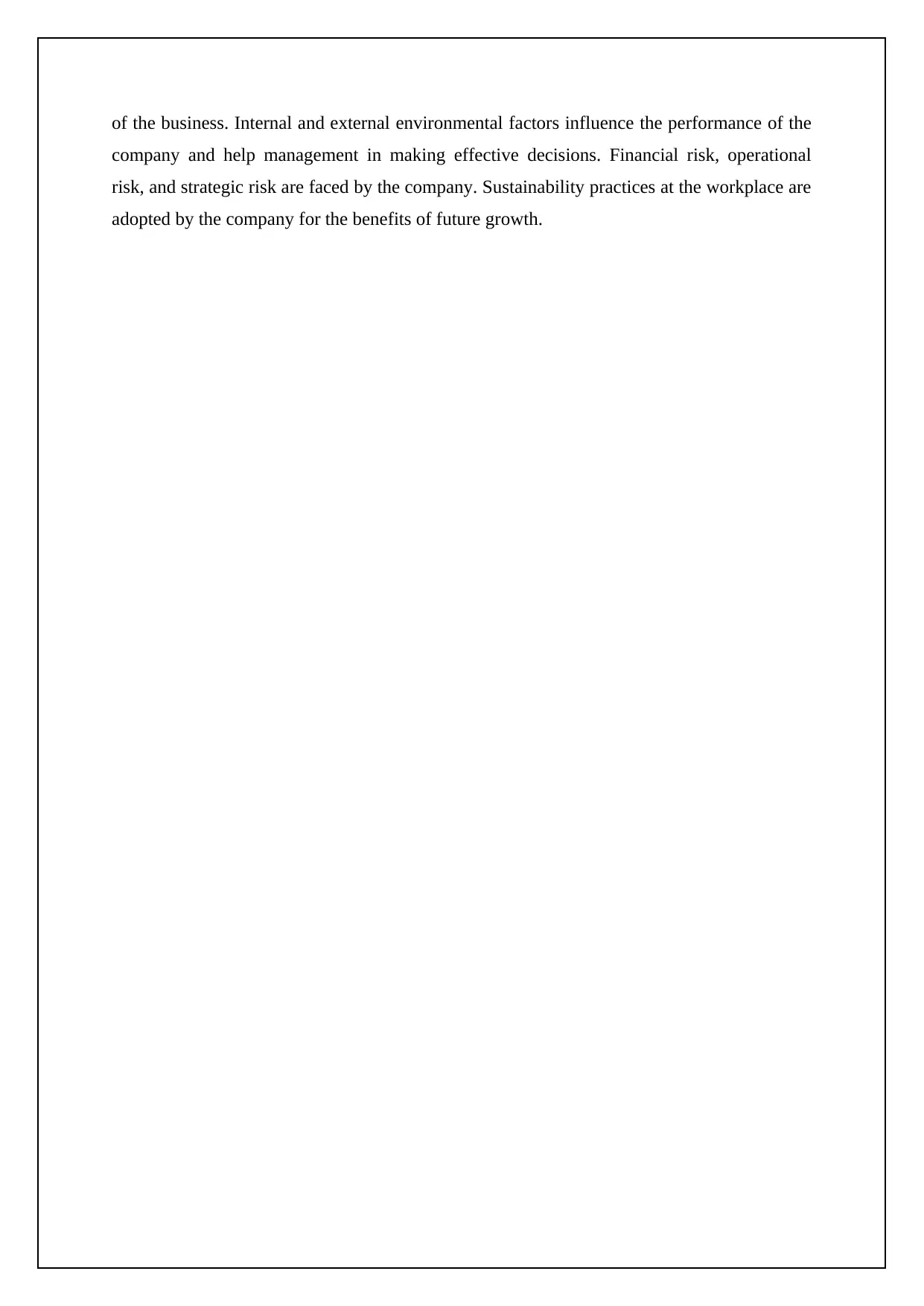
of the business. Internal and external environmental factors influence the performance of the
company and help management in making effective decisions. Financial risk, operational
risk, and strategic risk are faced by the company. Sustainability practices at the workplace are
adopted by the company for the benefits of future growth.
company and help management in making effective decisions. Financial risk, operational
risk, and strategic risk are faced by the company. Sustainability practices at the workplace are
adopted by the company for the benefits of future growth.
Paraphrase This Document
Need a fresh take? Get an instant paraphrase of this document with our AI Paraphraser
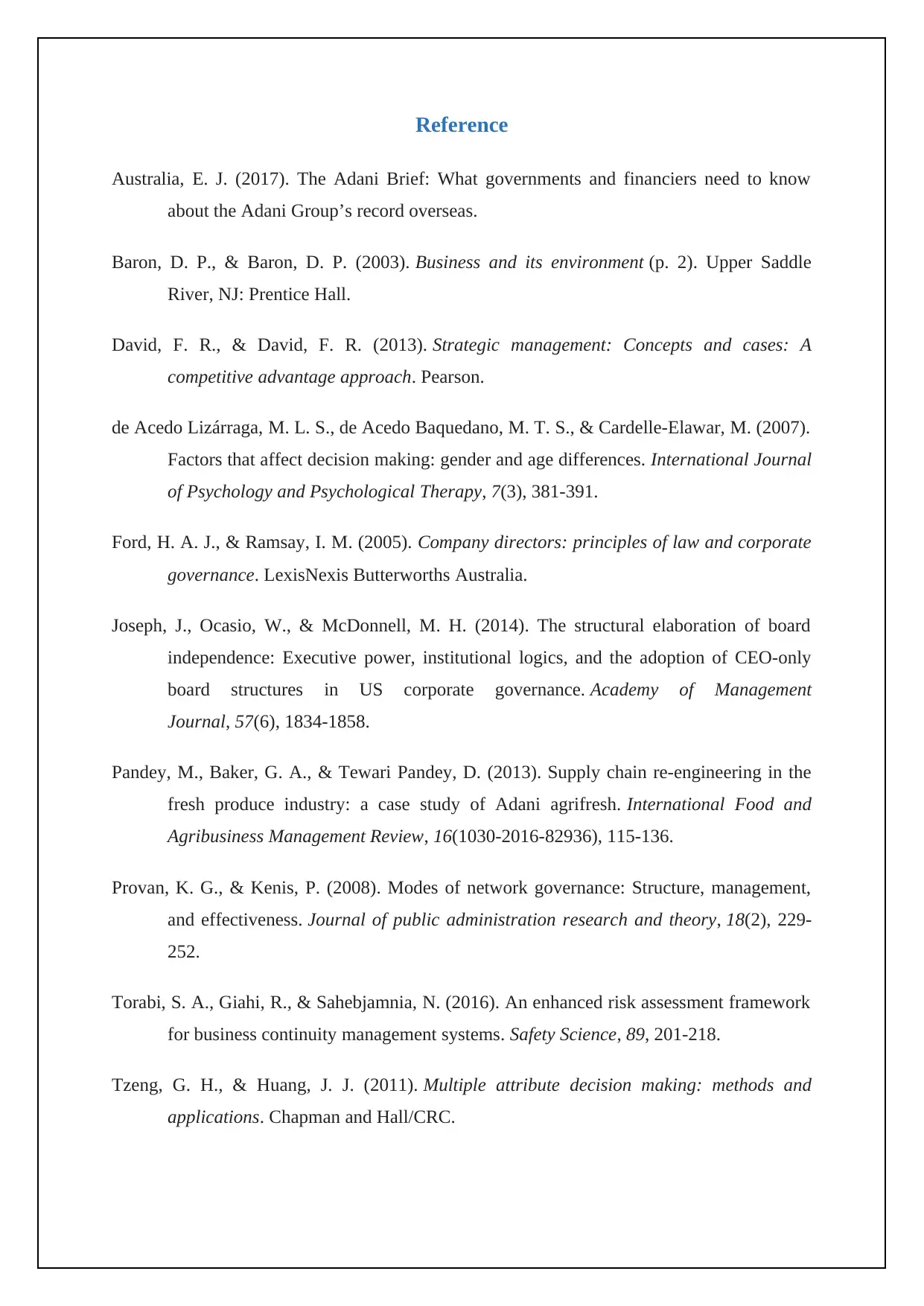
Reference
Australia, E. J. (2017). The Adani Brief: What governments and financiers need to know
about the Adani Group’s record overseas.
Baron, D. P., & Baron, D. P. (2003). Business and its environment (p. 2). Upper Saddle
River, NJ: Prentice Hall.
David, F. R., & David, F. R. (2013). Strategic management: Concepts and cases: A
competitive advantage approach. Pearson.
de Acedo Lizárraga, M. L. S., de Acedo Baquedano, M. T. S., & Cardelle-Elawar, M. (2007).
Factors that affect decision making: gender and age differences. International Journal
of Psychology and Psychological Therapy, 7(3), 381-391.
Ford, H. A. J., & Ramsay, I. M. (2005). Company directors: principles of law and corporate
governance. LexisNexis Butterworths Australia.
Joseph, J., Ocasio, W., & McDonnell, M. H. (2014). The structural elaboration of board
independence: Executive power, institutional logics, and the adoption of CEO-only
board structures in US corporate governance. Academy of Management
Journal, 57(6), 1834-1858.
Pandey, M., Baker, G. A., & Tewari Pandey, D. (2013). Supply chain re-engineering in the
fresh produce industry: a case study of Adani agrifresh. International Food and
Agribusiness Management Review, 16(1030-2016-82936), 115-136.
Provan, K. G., & Kenis, P. (2008). Modes of network governance: Structure, management,
and effectiveness. Journal of public administration research and theory, 18(2), 229-
252.
Torabi, S. A., Giahi, R., & Sahebjamnia, N. (2016). An enhanced risk assessment framework
for business continuity management systems. Safety Science, 89, 201-218.
Tzeng, G. H., & Huang, J. J. (2011). Multiple attribute decision making: methods and
applications. Chapman and Hall/CRC.
Australia, E. J. (2017). The Adani Brief: What governments and financiers need to know
about the Adani Group’s record overseas.
Baron, D. P., & Baron, D. P. (2003). Business and its environment (p. 2). Upper Saddle
River, NJ: Prentice Hall.
David, F. R., & David, F. R. (2013). Strategic management: Concepts and cases: A
competitive advantage approach. Pearson.
de Acedo Lizárraga, M. L. S., de Acedo Baquedano, M. T. S., & Cardelle-Elawar, M. (2007).
Factors that affect decision making: gender and age differences. International Journal
of Psychology and Psychological Therapy, 7(3), 381-391.
Ford, H. A. J., & Ramsay, I. M. (2005). Company directors: principles of law and corporate
governance. LexisNexis Butterworths Australia.
Joseph, J., Ocasio, W., & McDonnell, M. H. (2014). The structural elaboration of board
independence: Executive power, institutional logics, and the adoption of CEO-only
board structures in US corporate governance. Academy of Management
Journal, 57(6), 1834-1858.
Pandey, M., Baker, G. A., & Tewari Pandey, D. (2013). Supply chain re-engineering in the
fresh produce industry: a case study of Adani agrifresh. International Food and
Agribusiness Management Review, 16(1030-2016-82936), 115-136.
Provan, K. G., & Kenis, P. (2008). Modes of network governance: Structure, management,
and effectiveness. Journal of public administration research and theory, 18(2), 229-
252.
Torabi, S. A., Giahi, R., & Sahebjamnia, N. (2016). An enhanced risk assessment framework
for business continuity management systems. Safety Science, 89, 201-218.
Tzeng, G. H., & Huang, J. J. (2011). Multiple attribute decision making: methods and
applications. Chapman and Hall/CRC.
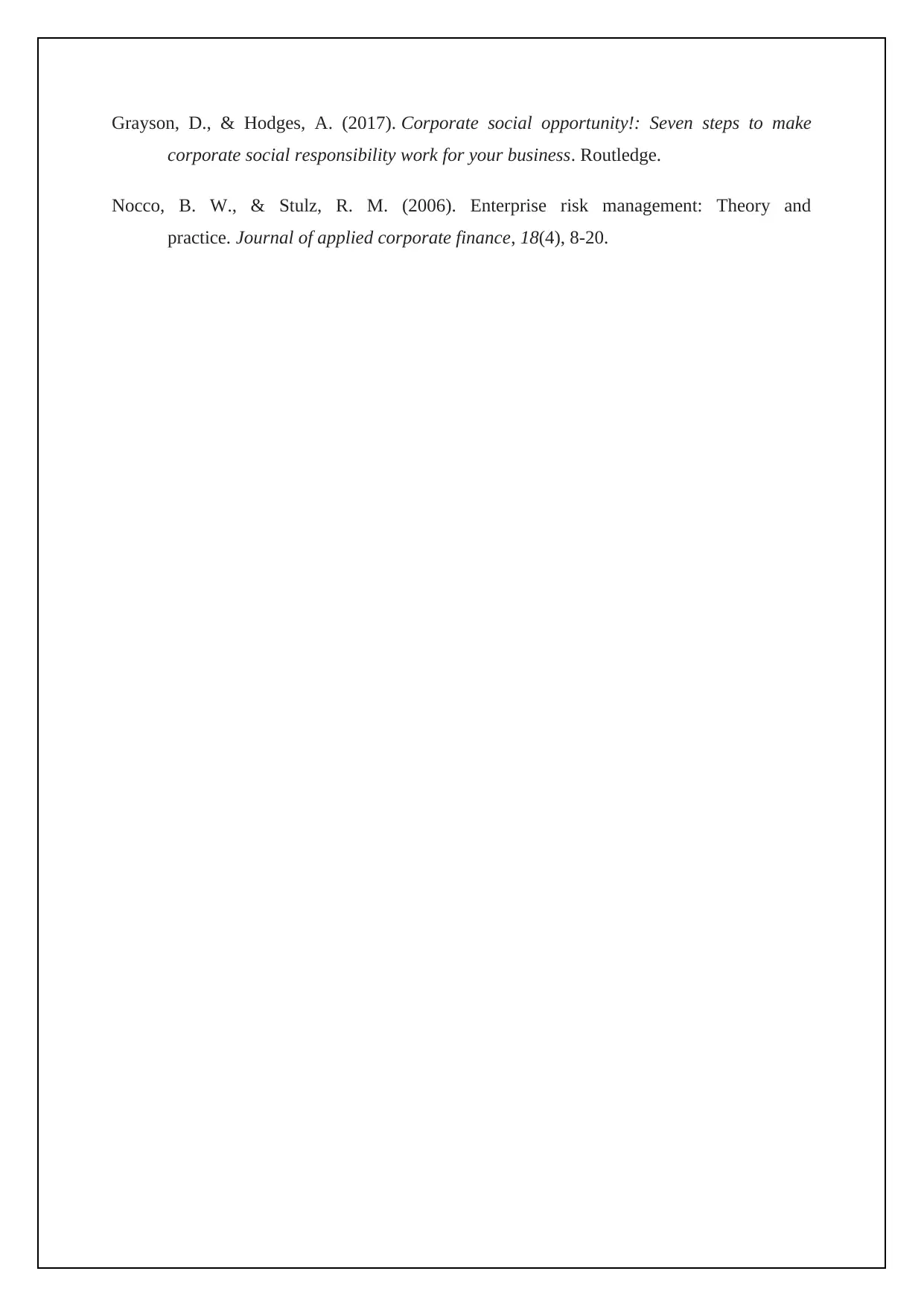
Grayson, D., & Hodges, A. (2017). Corporate social opportunity!: Seven steps to make
corporate social responsibility work for your business. Routledge.
Nocco, B. W., & Stulz, R. M. (2006). Enterprise risk management: Theory and
practice. Journal of applied corporate finance, 18(4), 8-20.
corporate social responsibility work for your business. Routledge.
Nocco, B. W., & Stulz, R. M. (2006). Enterprise risk management: Theory and
practice. Journal of applied corporate finance, 18(4), 8-20.
⊘ This is a preview!⊘
Do you want full access?
Subscribe today to unlock all pages.

Trusted by 1+ million students worldwide
1 out of 9
Related Documents
Your All-in-One AI-Powered Toolkit for Academic Success.
+13062052269
info@desklib.com
Available 24*7 on WhatsApp / Email
![[object Object]](/_next/static/media/star-bottom.7253800d.svg)
Unlock your academic potential
Copyright © 2020–2025 A2Z Services. All Rights Reserved. Developed and managed by ZUCOL.




